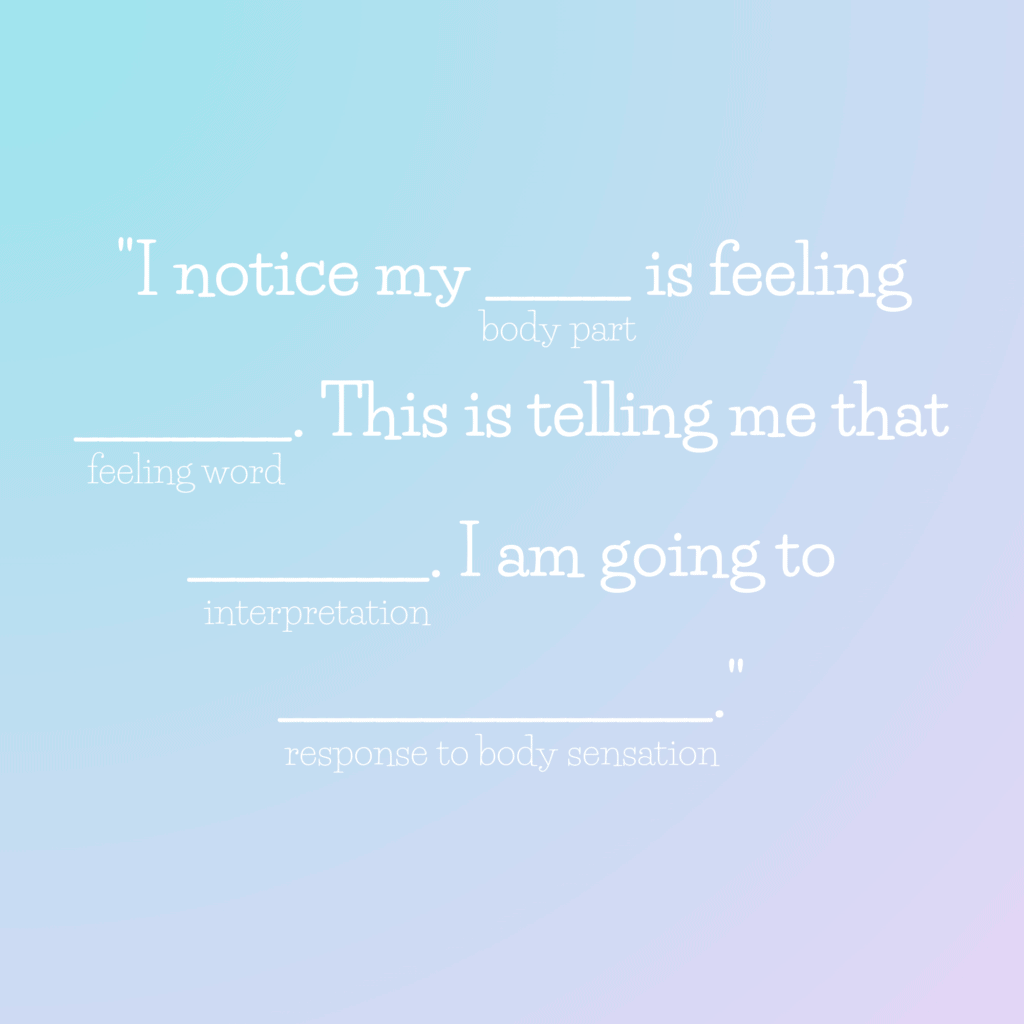If your child struggles with emotional outbursts, anger, tantrums, or overall regulation, they likely have reduced interoception. Interoception is a person’s ability to make sense their bodily signals. For example, a person might identify that they are hungry based on lack of energy, feeling cranky, their stomach grumbling, or feeling light-headed. However, your body signals don’t just tell you about your biological needs – they also tell you about your emotional state. In fact, our bodies have usually already sent us signals of distress before we even noticed that we are upset, frustrated, or anxious. Therefore, tuning into our body’s signals is vital for emotional regulation, as it allows us to catch the emotions early, before they become bigger than we can handle.
What is interoception?
Interoception is the skill of being aware of and able to interpret the body’s internal signals. Some interoceptive signals are:
- Hunger – grumbling stomach, irritability, light-headedness
- Fatigue – headache, loose muscles, irritability
- Needing to urinate – pressure and/or pain in the bladder
- Thirst – dry mouth, headache
How does interoception impact emotional regulation?
In order to feel okay, we need to attend to our body signals. For example, if we do not notice our hunger signals, we can become even more irritable, start to feel dizzy, or even pass out. Therefore, responding to our interoception signals is a key component of self-regulation.
In fact, studies have found that people with mental health disorders including anxiety, eating disorders, depression, or ADHD are significantly more likely to register difficulties with interoceptive awareness than those without mental health disorders. This further emphasizes the importance of interoceptive awareness for regulation and mental wellness.
Can interoception improve? And will it help with regulation?
The good new is that yes, interoception can improve! There are numerous studies that indicate improvement in behavior and regulation following interoception-based intervention. Half of randomized control trials in adults, children, and adolescents with mental wellness challenges found improvement in symptoms following interoception programs. Therefore, when completed in an evidenced-based manner, interoceptive training can be effective for improving emotional regulation in children.
How can I enhance my child’s interoception?
Use “body talk”
One of the most important ways we influence our children is by what we say to them. Therefore, if we want to improve our child’s interoception, we want to make sure we are talking about it and modeling it. An easy way to do this is through “body talk”. Body talk involves labeling things that are going on in our bodies (or in the bodies of others) and then interpreting it for our children. I promise, this is easier than it sounds!
Broken down, this sounds like: I notice my (body part) is feeling (feeling word). This is telling me that (interpretation). I am going to (response to body sensation).

Examples:
- I notice my stomach is grumbling. It is making noises and I feel the vibration. This is telling me that I am hungry, so I’m going to start making lunch.
- I notice that my heart is beating fast. I think I am getting worried about a presentation that I have at work. I am going to take a deep breath and workout so I can manage my anxiety.
- I notice that my eyes are feeling heavy. I think I am getting tired. I am going to do some jumping jacks to wake my body up so I can finish making dinner.
Incorporate body checks into your daily routine
Interoception is a form of mindfulness. It requires us to pause and pay attention to what is going on in our bodies. By incorporating body checks into our daily routines, we are better attuned to these signals.
One easy way to incorporate interoception is to use body talk at meals. Ask your child how their bellies are feeling before and after meals. You can also point out energy levels before and after meals.
Similarly, you can incorporate interoception into your child’s toileting or bedtime routines. You can ask them how their bodies are feeling before and after going to the bathroom, and how they feel before going to bed or waking up. Some children might need help identifying how their bodies feel, depending on their age and cognition. Younger children may benefit from modeling. If they do not become defensive, you can also help label for them (i.e. I hear your belly grumbling, or I see you wiggling more – it looks like you might need to go to the potty).
Visual supports can be a great, interactive way for children to complete body checks more independently and can be hung up in a certain spot to help you remember to complete the body check. I offer a great, easy to use visual that supports children who are still learning to read. You can purchase it here or by clicking on the image below.

What are your favorite ways to incorporate interoception into your family’s routine? Leave a comment and let me know!
Looking for other ways to improve your child’s emotional regulation? Check out my free breathing guide here.

